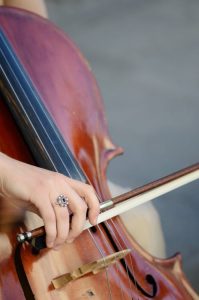
 ♦ Fundamentals: The study of note names and the SOLMISATION process is elementary and is a reference point for any musician or sound engineer. It is a notion that we will need to be able to continue advancing in music theory, since we will be able to understand in depth the theory of intervals, scales and chords that become essential elements of the arrangement and composition.
♦ Fundamentals: The study of note names and the SOLMISATION process is elementary and is a reference point for any musician or sound engineer. It is a notion that we will need to be able to continue advancing in music theory, since we will be able to understand in depth the theory of intervals, scales and chords that become essential elements of the arrangement and composition.
In order for you to understand and take advantage of the contents of this article, we recommend that you have read and understood the following previous articles:
Some basics: The definition of semitone (Half Tone)
When it comes to building tools and methods for writing and reading music, different systems have been adopted to give them their own names. proper names to the frequencies. Giving a specific name to a frequency has come to be known as the the process of solmisation.
The history of how the different frequencies in different cultures were named is a topic beyond the scope of this article. Basically assigning a proper name to each frequency or note (the note is a chosen portion within all the subtle variations of the frequency of a sound) is arbitrary. In some cases numbers, letters, or syllables have been used. In fact, depending on the context in which we move we can name the musical notes with letters (A, B, C, etc) or with syllables (DO, RE, MI, etc).
When we talked in the acoustics article about the heights of sounds, we saw that these were measured in frequencies. For example, a central note of a piano (the A) had a fundamental frequency of 440 Hz. In other words, it produces vibration cycles about 440 times per second. Now, the piano string that is half its length, (half its mass and therefore vibrates faster) produces a higher pitched sound sensation. This note vibrates about 880 times per second. And it is also an A. (Remember that Hz or Cycles per second, is the way to express how many vibrations a sound body makes per unit of time).
This gives rise to the concept that in any musical system is the octave ratio. octave ratio between a frequency (110 Hz) and the Double of the same frequency (220 Hz). These frequencies sound “musically similar”. In other words, they are not the same. They are not the same sounds, the one with more Hz is sharper than the one with less. But they sound similar.
Then why the name Octave? Because when this acoustic principle was established, the instruments available for making music did not have all the sounds we use now. Ancient musical systems sometimes had 5 notes, sometimes 7 notes, all of them with proper names. And when we reached the double frequency, because of its similarity in sound, the EIGHTH NOTE was given the same name as the FIRST NOTE.
Sound examples and the concept of Equal Octave Division:
A5 central 440 HZ
A6 (one octave higher) 880 HZ
A4 (one octave lower) 220 HZ
In reality, between one sound that has a specific frequency and another, there are INFINITEintermediate steps. Not only is this true mathematically speaking, but we can hear that difference. In the following audio example we start with a frequency of 220 Hz (A “A” or “A”) and go to twice the frequency, i.e. 440 Hz (another “A” or “A”, but as an octave ratio),
 The truth is that, with the passing of time and the production of written musical works, the system that has been imposed in reason of use in western music, is the one that contemplates the division of the octave, in twelve steps called SEMITONES (half tone).
The truth is that, with the passing of time and the production of written musical works, the system that has been imposed in reason of use in western music, is the one that contemplates the division of the octave, in twelve steps called SEMITONES (half tone).
The smallest distance (written in traditional notation) between two sounds, in the Western musical system, is the semitone (1/2 tone). On a piano, a semitone is given by the passage from one key to another (including black keys). On a guitar, each fret implies a semitone gradation. On fretted string instruments such as violins, violas, etc., there is no physical division on the handle of the instrument, so the player must adjust the tuning with his sense of hearing.
In fact, this seems to be a disadvantage, but it will be seen later as an expressive advantage. In wind instruments, the system of keys, valves and pistons is also designed to function within the semitone system. What happens is that with the embouchure, or blowing pressure, the wind player can cause variations of less than a semitone.
In the following example of Raphsody In Blue, the clarinet that starts the phrase can just access the target note, passing through the intermediate frequencies.
The traditional Western system divides this octave into 12 equal semitones in gradation. This occurs from 1788 onwards where the equal temperament system is adopted. Before that, the twelve semitone steps were not set at the same distance. (Because it was tuned by cycle of natural fifths). With the appearance of the rise of keyboard instruments (organs, harpsichords, spinettas, etc.) it became necessary to adopt the compromise solution of equal octave distribution.

The following semitone is obtained by using the constant Zarlino. “k” (k = 1,059463). That is to say that to get the next semitone I have to multiply the original Frequency by the coefficient: k and thus I get the value in Hz for the next semitone. If I do this multiplication twelve times, I get twice the frequency, i.e. the octave ratio.
The process of naming frequencies
For a historical and scientific reason (based on the error of the Pythagorean comma) not all frequencies were given proper names in the process of solmisation. Only seven names were created from the erroneously named “notes”. natural“and invented a system for naming the notes “altered“. The method is very simple: To a note that has a name (natural) if we want it to go up a semitone, we put the symbol “#“and if we want it to go down a semitone, then: “b“ . # the sharp, which indicates + ½ tone. b the Flat, which indicates – ½ tone.
There are two main systems of naming the notes, the Italian solfège that names them: Do, re, mi, fa, sol, sol, la, si, do. On the other hand, there is the German system of the 12th century that names them from the central A, with letters: A, B, C, D, E, F, G, A. (wrongly known as American).

The MIDI standard names the notes with numbers ranging from 0 to 127. Central C (the frequency of 261 Hz) being the note number 60 and going up or down one numerical value for each semitone.
The following is a table of equivalences between the frequency in Hz (for the A calibrated at 440 Hz), in Italian solfège, German solfège, and the MIDI note number:

To obtain the other notes of the Western musical system, simply multiply the frequency value by the coefficient k (Zarlino’s constant) and repeat the naming scheme as shown in the table below.
Let’s see how this translates to an instrument such as the piano:


Now let’s see what happens on the guitar: Needless to say, in the equal temperament system, the following is called Bb, o A# the note between the A and the B

Now let’s look at a chart of the relationship between the piano keyboard and the writing on two staves of traditional notation:

To understand how this translates to wind instruments, you should consult your own tablature. Tab tablatures are maps that indicate where to find each step from one frequency to another in relation to the mechanics of the instrument itself. To find the steps in the voice, there is nothing else to do but to train the voice with a good teacher and to know the sensation that makes us be in tune, passing from one note to another with precision in the placement of the phonatory apparatus.
And finally, this is how we would express semitones in traditional musical notation:

Finally, and to better understand the process, those who wish to deepen the concept of Equal Temperament of the notes, we definitely recommend the following video.
(It does not have good quality, but it does have Spanish subtitles).
The same video dubbed in Spanish:
 This article has passed the verifications of the Audiomidilab Academic Council, and is therefore certified by specialists in the field. This means that it is formally correct and proves to be a reliable source of information.. Every article written by an author or submitted by a correspondent or contributor undergoes this rigorous certification system.
This article has passed the verifications of the Audiomidilab Academic Council, and is therefore certified by specialists in the field. This means that it is formally correct and proves to be a reliable source of information.. Every article written by an author or submitted by a correspondent or contributor undergoes this rigorous certification system.



